Arrival in Sarajevo, our Latest Potential Expat Destination
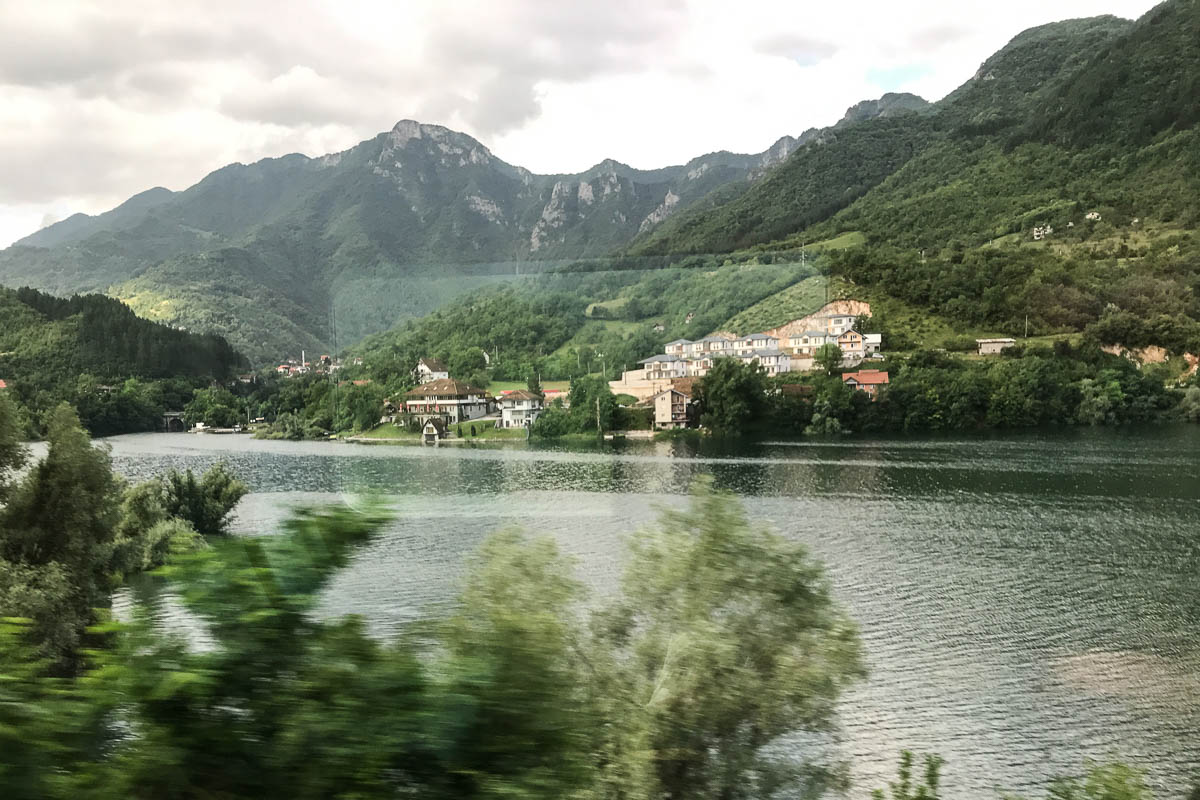
The approximately two-hour train ride from the heat of Mostar traveled through lush green mountains to the hill enshrouded valley that contains Sarajevo. Another awesome train ride and a great way to spend a morning! Emerging in the Communist era train station with the smell of old smoke was not. As we walked about 45 minutes from the train station to our Airbnb apartment, our first impression was “gritty”. By the time we reached our apartment, we were both thinking, there’s something about this town that we like.

Sarajevo, the capital city of Bosnia and Herzegovina (BiH), reminded us a bit of Medellin , another potential expat destination, but on a smaller scale. Like Medellin, Sarajevo is surrounded by green hills that rise above the city. Another similarity is the friendliness of the people. As we were climbing the hill in search of our apartment, two people stopped at different points to help us.

Our very comfortable apartment, at $22 per night, with a hospitable host who lived in the building, was in a typical and friendly neighborhood, Bistrik , just above and across the Miljacka River from Baščaršija, Sarajevo’s old town. We were also a bit above and one block over from the Sarajevo (Sarajevska) Brewery. The brewery, built in 1864, is thought to be the oldest industrial establishment in Sarajevo. The brewery played an invaluable role during the 1992-1995 war, not for its beer but for the natural springs that run beneath it.
Orientation to Sarajevo
As in many other cities we visited, we decided to do a free walking tour. We chose Neno and Friends , did the 2.5 hour East Meets West tour, and very glad we did. The tour met at the Susan Sontag Square. Susan Sontag was an American writer, filmmaker, philosopher, teacher, and political activist. She was a journalist in Sarajevo during the war. Sontag refused to stay at the comfortable and more secure Hotel Holiday (Holiday Inn at the time) with other journalists while the people of Sarajevo lived the hardships of war. Reportedly, she went to the hotel daily and left with her backpack filled with food to feed the people of the city.

Neno filled us in on 500 years of history, shared his insight, and showed and explained the major sights in and near Baščaršija. We think Neno’s passion for his country, its history, and its people is part of why Sarajevo has become our latest potential expat destination. He emphasized that even now, unlike other parts of BiH, different ethnic groups live harmoniously together, that this was always one of Saravejo’s strengths. He also presented a pros vs. cons of Yugoslavia under Tito.
Sarajevo Sights


Among other sights, the tour included a Serbian Orthodox cathedral, a Franciscan church, a mosque, and a synagogue. Although the population of Sarajevo is 80% Bosniaks (Muslim), other ethnic groups live in harmony in Sarajevo.
We also visited the site and learned the more accurate details about the event that triggered WWI. The assassination of Archduke Franz Ferdinand of Austria occurred from a café across the street from the famous Latin Bridge. The only reason it succeeded was that no one had informed the driver of a change of plans after the first assassination attempt. So he made a wrong turn, and ended up backing up right in front of the would-be assassin, Gavrillo Princip
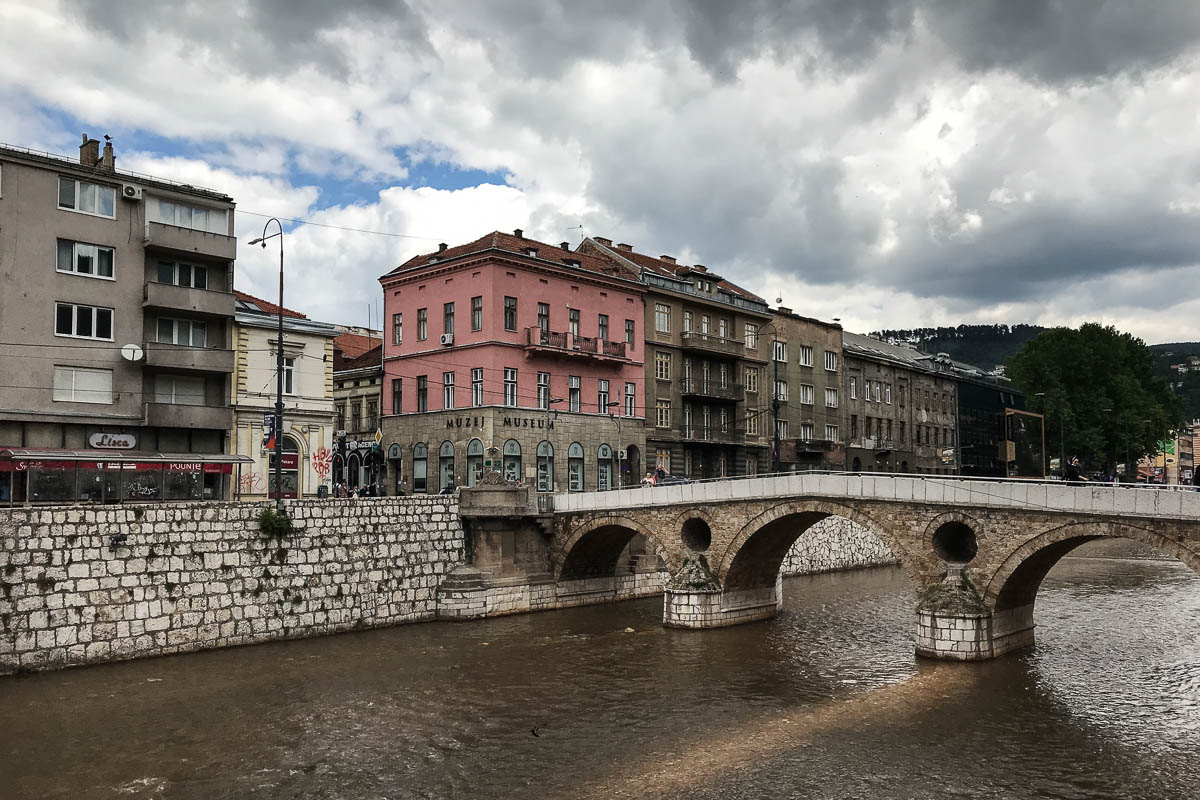
Neno also took us through the Baščaršija and explained how every street used to be for a different trade. Today, the only street that remains dedicated to one trade is that of coppersmiths.

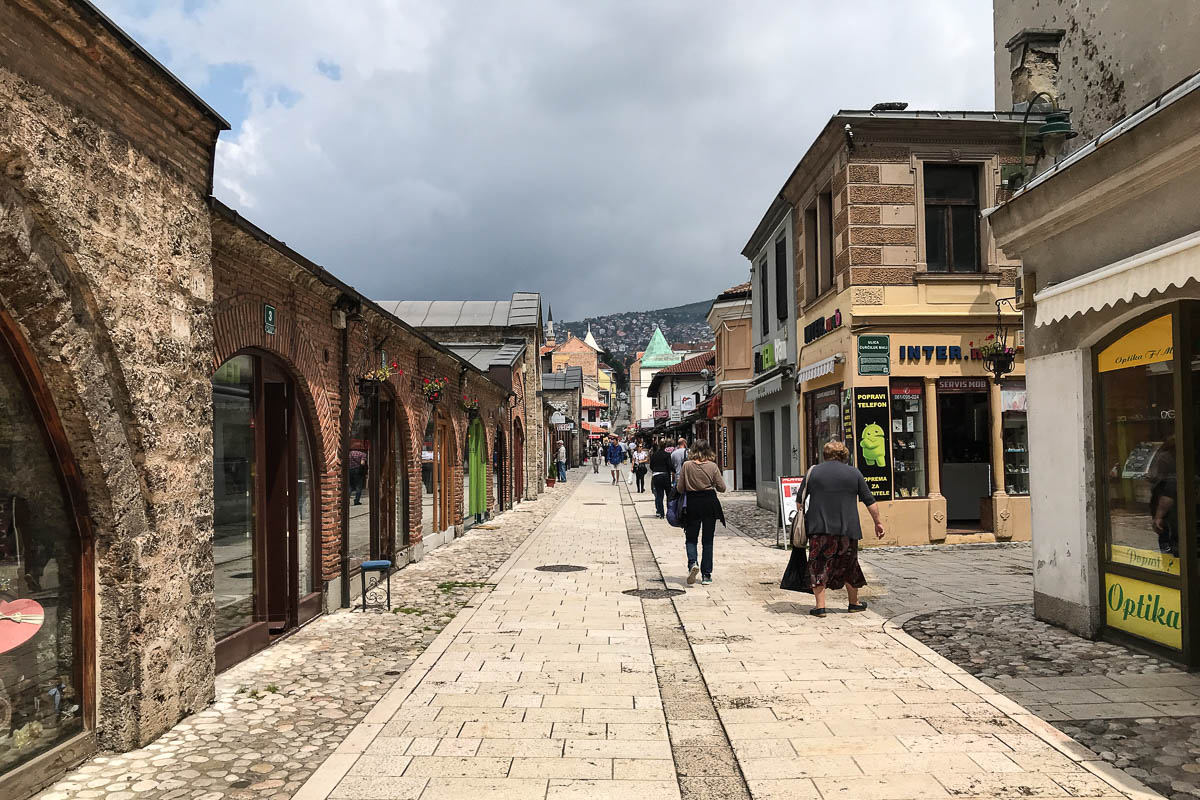
The Papagaj, the Bright “Ugly” Building
We got to visit the Papagaj building, referred to by locals as the “ugly” building. The Communists built this bright green and yellow building prior to the 1984 Olympics to show the world that Communism was not all ugly and gray. Today, this bright green and yellow building truly stands out. The interior of the ground floor displays a variety of street art, and the apartments command some of the highest rents in the city.
Reminders of the 1992-1995 War
As a result of the 44-month siege, Sarajevo has many buildings with bullet holes. For more details about the war, please see our Mostar post here. Sarajevo has perhaps more visual reminders of the war than Mostar. Since the large majority of the population is Muslim, mosques (large and small) are everywhere throughout the city. Most if not all of the many small mosques have small graveyards with new white tombstones with dates from the early 1990’s. A park contains a memorial to children killed during the siege on Sarajevo. Other parks contain small cemeteries and the hills are dotted with other cemeteries.

The Sarajevo Roses
Many of the craters left in the pavement by fatal mortar attacks have been filled with red resin, as a reminder of the those killed at that spot. Since the impressions remind some of a memorial rose, these craters were given the name, “Sarajevo Roses”. As new asphalt is poured, the Sarajevo Roses are gradually disappearing, but perhaps more quickly than other memories and reminders of the war.

Museums in Sarajevo
We skipped the Museum of Crimes Against Humanity and Genocide 1992-1995 because it’s almost identical to the one in Mostar. We did visit three other museums. Admission prices for the museums in Sarajevo are considerably low.
War Childhood Museum
The War Childhood Museum opened at the beginning of 2017. The museum was inspired by a book, “War Childhood: Sarajevo 1992-1995”. The book is more of a project, inspired by Jasminko Halilovic, who was a child during the war. Both the book and the museum include words, phrases, and childhood objects contributed by more than 1000 people who were children during the war. The book has been translated into several languages (including English). The museum was awarded the 2018 Council of Europe Museum Prize and plans outreach and exhibitions in other countries.
Jewish Museum of Bosnia and Herzegovina
The Jewish Museum of Bosnia and Herzegovina opened in 1966. It is housed in the oldest synagogue in Bosnia and Herzegovina, built in 1581. Jews first came to BiH during the Spanish Inquisition and lived peacefully during the times of Ottoman rule. The museum shows the 400-year history of Jews in Bosnia and Herzegovina. Displays include religious items, documents and records, and photos and information of prominent people. There is also a section on the fate of the Jewish people in BiH during WWII. Jews again fled during the 1992-1995 war. While the Jewish community in Sarajevo is small (about 800), there are signs that it’s starting to rebuild. In 2016, there were 12 births and about the same number in 2017. Overall, we thought the museum, housed in the old synagogue, was well worth a visit.

The Sarajevo Haggadah
The museum also has a facsimile of the famous Sarajevo Haggadah. The original is in the National Museum of Bosnia and Herzegovina. We were led to believe that the Sarajevo Haggadah was not currently on display and learned too late that it was, in fact, displayed for a couple hours two days per week. We were interested in seeing the Haggadah after reading “People of the Book”, an historical novel by Geraldine Brooks, which we highly recommend.
Sarajevo Brewery Museum
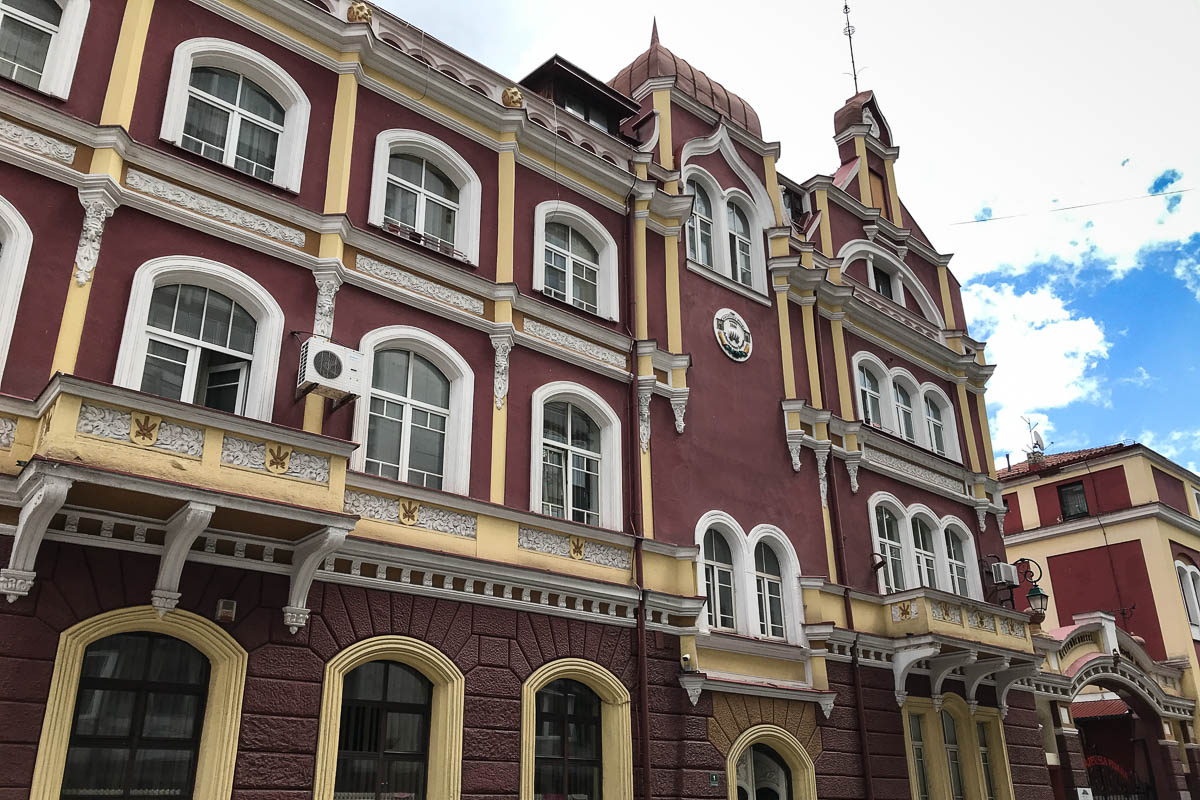
As mentioned earlier, the Sarajevo Brewery has been in continuous production (reduced production during the war) since 1864. The small one-room museum briefly covers the brewery’s history and highlights its many awards. Entrance to the museum includes a free beer in the adjacent restaurant, with its interesting dark old school interior. We enjoyed the beer, preferred the dark. We were told that the food wasn’t that great.
Gallery 11/07/95
The last and certainly the hardest museum for us to visit was Gallery 11/07/95 a museum dedicated to remembering the events leading up to the genocide that happened in Srebrenica on that date. In an area that was declared a safe zone by the UN, and Muslim refugees were encouraged to relocate there. Against the agreed-upon cease fire, the army of the Republica Srpska (RS) attacked Srebrenica, and refugees flooded to the UN base at Potocari. Sensing what would happen once the town fell, many of the men and boys left the area and attempted to hike over the mountains to Free Bosnia. Along the way, the RS army set traps, captured some of the refugees, and encouraged others to come out of the hills promising safe passage. Only to kill them once they emerged.
Once Srebrenica fell, the UN forces forced the refuges to leave the UN base in Potocari. Whereupon most men and boys older than 12 were rounded up, taken out of town, where they were executed and buried in mass graves. The graves were later dug up and relocated to try and cover up what had been done. All in all, over 8000 unarmed Muslims, mostly men and boys, were killed as Europe stood by.
Sarajevo’s Low Cost of Living
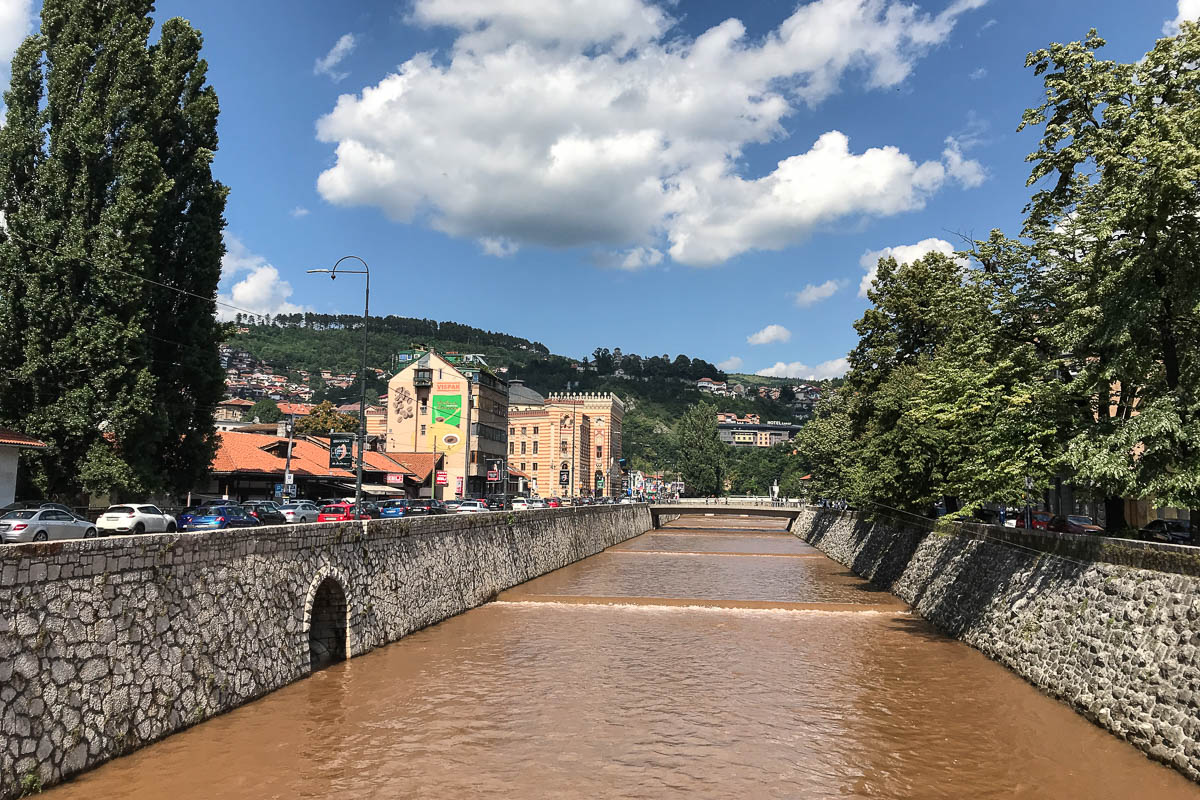
We like the overall vibe of the city, its setting at the base of the mountains, and its friendly, helpful people. Another reason that Sarajevo has become another potential expat destination for us is its low cost of living. Groceries were the cheapest we’ve found since our visit to Medellin last winter. Restaurant prices are also quite low, and the food is outstanding! A typical lunch out for us included two hearty Bosnian dishes, bread, and a half liter of wine for 23-27 BAM (Bosnian Convertible Mark), or $13-16 . A couple restaurants we can recommend, right in the heart of the old town, are Barhana and Club “To Be”. The latter is small, quaint, and a bit more expensive; our hearty lunch with wine was $25. We went to Barhana three times!

Bosnian Food

Some of our favorite dishes are spicy chicken stew and thick white bean soup. One of two foods associated with BiH is ćevapi or ćevapčići, mixed meat grilled skinless sausages. A popular lunch is ćevapčići served in a very large pita type bread with raw onions and sour cream with spices on the side. Another dish is burek, a filled pastry. Fillings are usually meat, cheese, potatoes, or spinach, generally prepared separately, not mixed together. While we enjoyed both dishes, we consider them in the category of occasional diet overload.
Whilst in Sarajevo, we found our favorite pèkara, or bakery. We discovered a chocolate pastry that we liked and our (at least Ann’s) favorite, a soft pretzel stick baked fresh several times per day.
Housing Costs in Sarajevo
Housing in Sarajevo is quite inexpensive. A 3-bedroom apartment in the heart of the old town, including in the “ugly”, building, rents for about the equivalent of 700 € (about $815) per month. Live on the outskirts of town in a Communist block tower, and a 3-bedroom apartment can be as low as 150 € ($175) per month. Sounds pretty good to us potential expats! However, minimum wage in Sarajevo is about 200 € ($233) per month with the average earnings being about 400 € ($467) per month.
More than half of young (maybe under 35?) people are “officially” unemployed. Many work under the table as employers are required to pay the government about one-third of an employee’s salary. Many young people live at home with their parents. This living situation in not necessarily bad, as family values are an important part of the culture.
Our Social Life in Sarajevo
Yes, we two introverts actually had a social evening out during our eight-day stay in Sarajevo. Through InterNations we met at a bar and socialized with a small group of locals and expats. Most of the expats in Sarajevo are younger. We enjoyed talking with a young man from Turkey who no longer wants to live under the current regime and doesn’t think much of US foreign policy. We did meet and chat with an interesting American woman of about our age who filled us in on life in Sarajevo for both locals and expats. She mentioned lots of great hiking in the hills surrounding Sarajevo. Unfortunately, since it rained most of the time we were there, we didn’t get to hike.
Why is Sarajevo a Potential Expat Destination for Us?
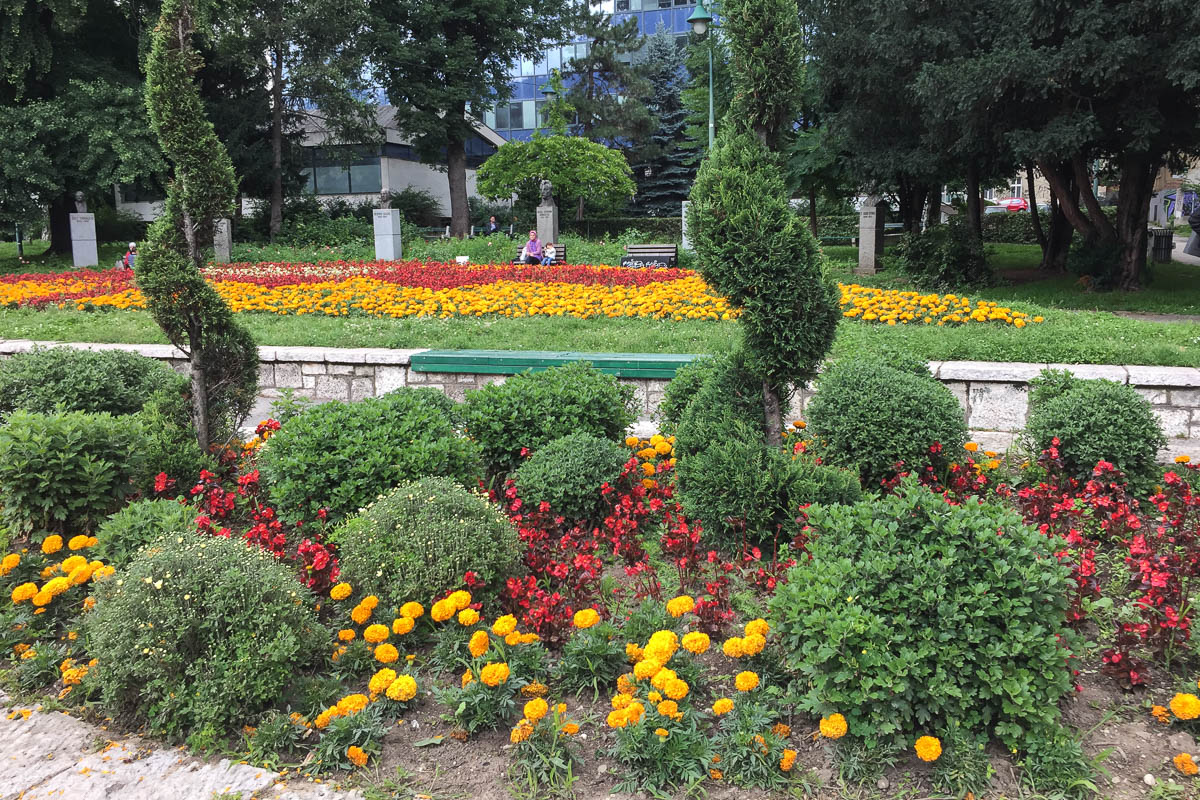
First, let’s make one thing perfectly clear: we’re talking summer. Summers are not too hot, but winters are very cold, and it snows. Ian no longer does snow, he gave it up as a New Years resolution a number of years ago. Another negative is that we couldn’t find decaf coffee anywhere, and we stopped in many grocery stores. Ian doesn’t do caffeine…Ian’s starting to sound like a bit of a curmudgeon. We think a couple of restaurants might serve decaf. Another potential problem: smoking is still allowed inside restaurants here. We wondered if this is a reflection of politics or perhaps after living through the war, people just want to enjoy life because it might be short.
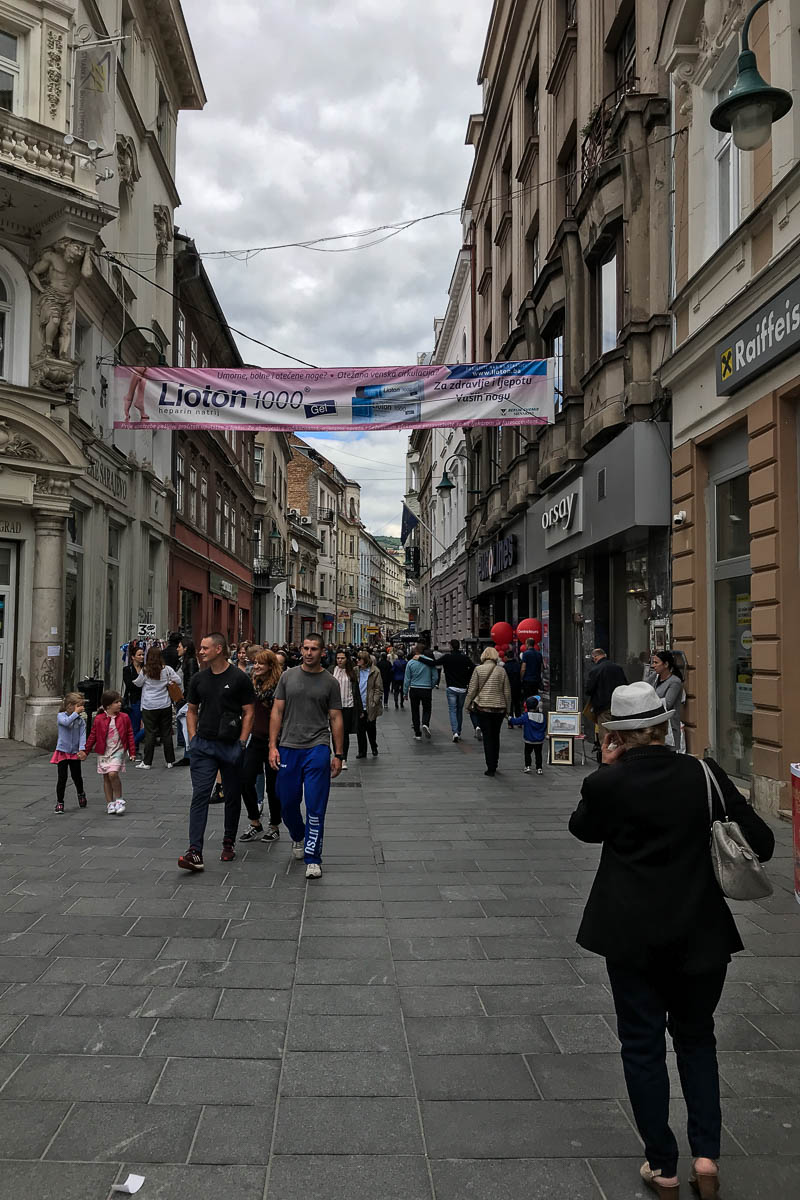
So why would we consider spending a couple months here in the summer? Something about Sarajevo just grabs us. An historical, somewhat gritty, and picturesque city surrounded by green hills and mountains, with good hiking. Good public transportation, with trams and buses. Cost of living is very low by Western standards. Friendly, helpful, hospitable people, with a kind of special spirit and outlook on life, despite (or perhaps because of) having lived through a horrendous war.

Next Up: Back to Croatia, this time the capital city of Zagreb
Ian & Ann
